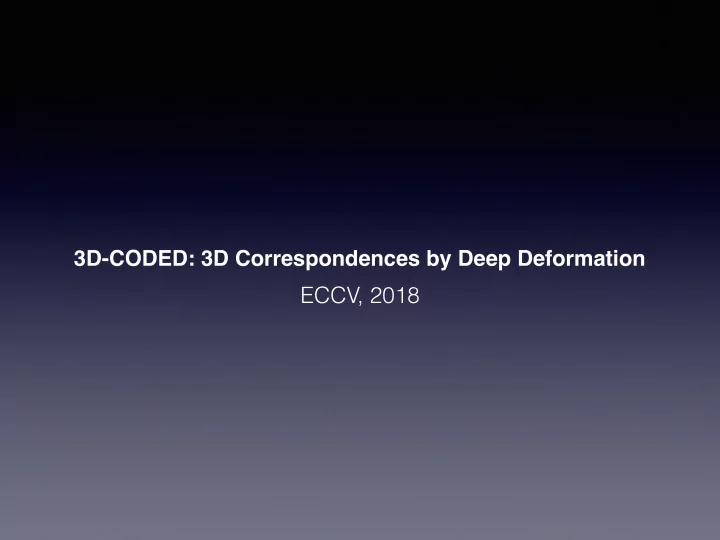

3D-CODED: 3D Correspondences by Deep Deformation ECCV, 2018
Outline • Abstract • Introduction • Related work • Method • Results • Experiments • Conclusion
Abstract • This paper proposes a new deep learning approach for matching deformable shapes by introducing Shape Deformation Networks which jointly encode 3D shapes and correspondences.
Introduction • This paper proposes Shape Deformation Networks , a comprehensive, all-in-one solution to template-driven shape matching. A Shape Deformation Network learns to deform a template shape to align with an input observed shape. Given two input shapes, they align the template to both inputs and obtain the final map between the inputs by reading off the correspondences from the template.
Related work
Related work Generic shape matching • To estimate correspondences between articulated objects, it is common to assume that their intrinsic structure remains relatively consistent across all poses. • HKS, WKS, conformal maps, heat kernel maps
Related work Template-based shape matching • While such template- based techniques provide the best correspondence results, they require a careful parameterization of the template. • Fitting this representation to an input 3D shape requires also designing an objective function that is typically non-convex and involves multiple terms to guide the optimization to the right global minima.
Related work Deep learning for 3D data • Existing networks operate on various shape representations • Volumetric grids • Point clouds • Geometry images • Multi-view images
Method
Key ideas • Learn to predict a transformation between shapes instead of directly learning the correspondences. • To learn transformations only from one template to any shape.
Method Overview
Encoder h 𝑦 1 MLP g 𝑦 2 MLP γ max Input point cloud MLP 𝑦 … MLP … Global representation MLP 𝑦 𝑜
Shape Deformation using Decoder Global representation x x Decoder y y z z
Total Loss for case 1: correspondences between the training data are available Where the sums are over all P vertices of all N example shapes
Total Loss for case 2: correspondences between the training data are not available Reconstructed Loss: Minimize the chamfer distance between the input shape and the reconstructed one Laplacian Loss: Encourage the Laplacian operator defined on the template and the deformed template to be the same (which is the case for isometric deformations of the surface) Edge Loss: Encourage the ratio between edges length in the template and its deformed version to be close to 1
Refinement Given parameters of the encoder and the decoder, minimize with respect to the global feature x the Chamfer distance between the reconstructed shape and the input.
Finding shape correspondences between 2 shapes 1. Get the reconstructed shape 2. Refine the reconstructed shape
Results
On testing data Input Shape Deformed Template After refinement
On other datasets
Interesting contribution
Experiments
The importance of initial guess
The importance of regularization term Point cloud Mesh Point cloud Mesh Input shape after optimization after optimization after optimization after optimization + + Regularization Regularization
Conclusion • An encoder-decoder deep network architecture can generate human shape correspondences using only simple reconstruction and correspondence losses
Recommend
More recommend